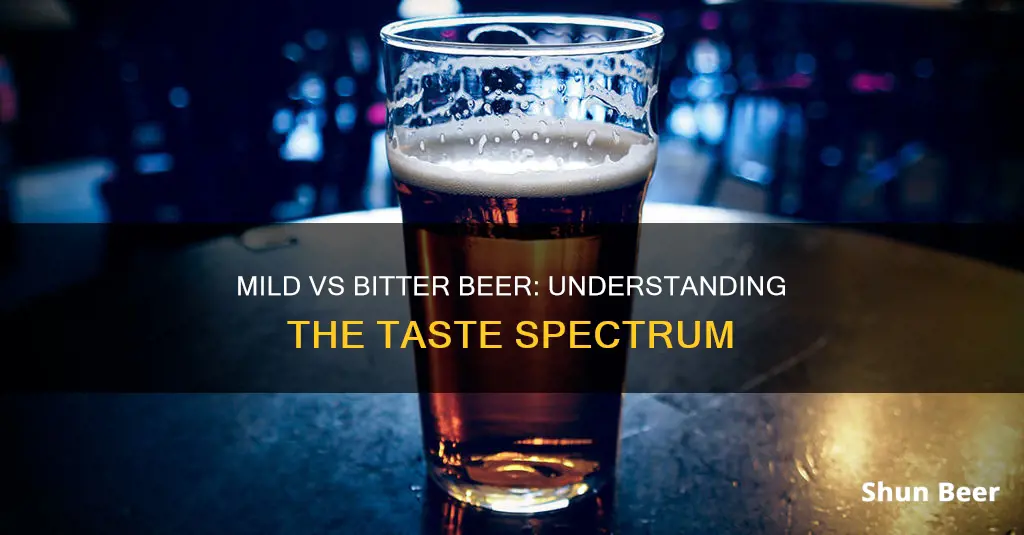
Mild and bitter beers are two distinct styles of English beer. Mild ales, which originated in Britain in the 17th century or earlier, were originally young, fresh, or unaged beers. Modern milds are typically dark-coloured, with an ABV of 3% to 3.6%, although lighter and stronger varieties exist. They are characterised by a lower hops content, allowing the malt flavours to shine through, ranging from roast and toast to malty sweetness, fruit, caramel, toffee, and chocolate. Bitter, on the other hand, is an English-style pale ale that varies in colour from gold to dark amber and in strength from 3% to 5.5% ABV. The term bitter refers to the focus on the floral, earthy, and resiny flavours of English hops, although they are not as overwhelmingly bitter as American-style IPAs. While bitters also feature malt flavours, the goal is to balance the hops and malt, creating a range of bitters from standard to extra special or extra strong.
What You'll Learn
- Mild ale colour: From dark amber to near-black, with lighter hues also available
- Mild alcohol content: ABV of 3% to 3.6%, with stronger milds reaching 6% ABV or higher
- Bitter ale colour: Gold to dark amber, with golden summer ale also available
- Bitter alcohol content: Typically 3% to 5.5% ABV, with premium bitters exceeding 5.5% ABV
- History of mild: Originated in Britain in the 17th century or earlier, with a sharp decline in popularity in the 1960s

Mild ale colour: From dark amber to near-black, with lighter hues also available
Mild ale is a type of ale that originated in Britain in the 17th century or earlier. "Mild" was originally used to refer to any beer that was young, fresh, or unaged, rather than a specific style of beer. Modern mild ales are mostly dark-coloured, ranging from dark amber to near-black, with an alcohol by volume (ABV) of 3% to 3.6%. However, there are also lighter-hued mild ales available, with an ABV of 6% and higher.
The colour of mild ale has evolved over time. In the 19th century, mild ales were typically pale in colour, ranging from pale gold to coppery/ruby hues. As public taste shifted towards darker beers, mild ales gradually became darker, with the use of darker malts and brewing techniques. By the mid-20th century, mild ales were established as darker beers than pale ales/bitters, ranging from reddish-brown to dark brown or black.
The colour of mild ale can vary depending on the brewing techniques and ingredients used. Base malts, such as Pilsner malt and pale malt, contribute to light straw to golden hues. Caramel or crystal malts add colours ranging from gold to amber and deep red. Roasted malts, such as chocolate malt and black malt, impart deep brown to black hues.
The Campaign for Real Ale has designated May as Mild Month, and modern microbreweries have led to a modest renaissance in the style, with an increasing number of mild ales being brewed. While mild ale is mostly unknown outside of Britain, it continues to have pockets of demand, particularly in the West Midlands and North West England.
Beer Gas vs CO2: What's the Difference?
You may want to see also

Mild alcohol content: ABV of 3% to 3.6%, with stronger milds reaching 6% ABV or higher
The alcohol content of beer is measured by percentage ABV (alcohol by volume). The ABV of beer varies, with lighter beers containing as little as 2% ABV and stronger beers containing over 10% ABV. The average ABV of beer is around 5%.
Mild ales typically have a lower ABV than bitter beers. Modern mild ales usually have an ABV of between 3% and 3.6%. However, there are stronger milds that reach 6% ABV or higher.
The term "mild" in relation to beer originally referred to young, fresh, or unaged beer. These young beers were often blended with aged "stale" beer to improve their flavour. As public tastes changed in the 19th century, unblended young beer, mostly in the form of mild ale or light bitter beer, became more popular.
Today, mild ales are mostly dark-coloured, although there are also lighter-hued varieties. The flavour of modern dark milds is dominated by malt, sometimes with roasty notes derived from the use of black malt. They have a subdued hop character, although there are some bitter examples. Light milds are generally similar but paler in colour, and some dark milds are created by adding caramel to a pale beer.
Stout vs Beer: What's the Difference?
You may want to see also

Bitter ale colour: Gold to dark amber, with golden summer ale also available
Bitter beer, or English-style bitter, is a pale ale that varies in colour from gold to dark amber. It has been described as "the national drink of England". The colour of bitter may be controlled by the addition of caramel colouring. It is similar to the India pale ale style of beer, though bitters are less hoppy.
Bitter beer's colour ranges from gold to copper, with a low residual malt sweetness. Hop bitterness is medium. The term "bitter" has been used in England to describe pale ale since the early 19th century. During the 20th century, bitter became the most popular type of draught beer sold in British pubs.
Bitter beer comes in different strengths:
- Session or ordinary bitter: up to 4.1% ABV. This is the most common strength of bitter sold in British pubs.
- Best or special bitter: between 4.2% and 4.7% ABV.
- Premium or strong bitter: 4.8% ABV and over.
Golden or summer ale has a similar appearance and profile to pale lager. Golden ale is typically brewed without the use of crystal malts or with a far lower quantity than traditional bitter.
Mild ale, on the other hand, is mostly dark-coloured, with an ABV of 3% to 3.6%, although there are lighter milds as well as stronger milds, reaching 6% ABV and higher. Modern dark mild varies from dark amber to near-black in colour and is very light-bodied. Its flavour is dominated by malt, sometimes with roasty notes derived from the use of black malt, with a subdued hop character.
English Mild can come in Dark or Pale form. A Pale Mild will have a bit of hoppy bitterness but the flavour will emphasise malt, with some fruitiness and even butteriness possible. A Dark Mild will have a lower hops quotient, but with more malt, yielding a slightly fuller body than a Pale Mild.
Draught vs Beer: What's the Difference?
You may want to see also

Bitter alcohol content: Typically 3% to 5.5% ABV, with premium bitters exceeding 5.5% ABV
Bitter beers typically have an alcohol content of between 3% and 5.5% ABV. The specific type of bitter beer will determine its alcohol content. For example, session or ordinary bitter has an ABV of up to 4.1%, while best or special bitter has an ABV of between 4.2% and 4.7%. Premium or strong bitters exceed 4.8% ABV.
The alcohol content of bitter beers can vary widely, from under 3% ABV to as high as 7%. The average bitter beer strength in the UK in 2020 was 4.2% ABV.
Bitters are a style of English pale ale that can range in colour from light gold to deep copper, or even dark amber. The term "bitter" has been used in England to refer to pale ales since the early 19th century. While these beers are characterised by their bitterness, they are not overwhelmingly bitter like American-style IPAs. Instead, the bitterness is balanced out by malt, with the proportion depending on the type of bitter.
Bitters are traditionally cask-conditioned and dispensed by gravity through a tap in the cask or by a beer engine at a "cellar temperature" of 11 to 14 °C (52 to 57 °F). The colour of bitter beer may be controlled by the addition of caramel colouring.
Sour Beers: A Unique Fermentation Process
You may want to see also

History of mild: Originated in Britain in the 17th century or earlier, with a sharp decline in popularity in the 1960s
Mild ale is a type of ale that originated in Britain in the 17th century or earlier. The term "mild" was originally used to designate any beer that was young, fresh, or unaged, and did not refer to a specific style of beer. Mild ales were sold young, while stale or keeping beers were aged before sale.
In the 18th century, mild ale was a very vague term that covered ales of all colours and strengths. It was not a specific style but simply described the level of conditioning. Mild ales of this period were considerably stronger than modern versions, with ABVs as high as 7%.
The popularity of mild ale began to decline in the 1960s, and it was in danger of disappearing entirely. This decline was due in part to changing tastes in Britain, with bitter and lager growing in popularity. Additionally, publicans would often empty any spills or serving slops into the mild ale, and brewers would produce lighter, less complex beers and add caramel colouring to market as mild.
However, the increase in microbreweries has led to a modest revival, with more mild ales (sometimes labelled "dark") being brewed. Today, mild ales are generally considered low-gravity beers with low hop rates and a predominantly malty palate. They typically have an ABV of around 3% to 3.6%, although stronger versions reaching 6% ABV or higher can also be found.
Ginger Ale vs Ginger Beer: What's the Difference?
You may want to see also
Frequently asked questions
Mild beer is a type of ale that originated in Britain in the 17th century or earlier. Modern mild beers are mostly dark-coloured, with an alcohol content of 3% to 3.6% ABV, although lighter-hued and stronger milds are also available, reaching 6% ABV and higher.
Bitter beer is an English style of pale ale that varies in colour from gold to dark amber, and in strength typically from 3% to 5.5% ABV. The term "bitter" has been used in England to describe pale ale since the early 19th century.
The main difference between mild and bitter beer is the colour and alcohol content. Mild beers are typically dark-coloured and have a lower alcohol content, ranging from 3% to 6% ABV. Bitter beers, on the other hand, are pale ales that range in colour from gold to dark amber, and have a slightly higher alcohol content, typically between 3% and 5.5% ABV, although they can go up to 7% ABV with premium or strong bitters.
In addition to the colour and alcohol content differences, mild and bitter beers also have distinct flavour profiles. Mild beers tend to have a lower hops content and a sweeter, malt-forward flavour, with notes of fruit and butteriness. Bitter beers, as the name suggests, have a more pronounced bitterness due to the use of floral, earthy, and resiny English hops. However, it is important to note that "bitter" does not refer to an overwhelmingly bitter taste, as the bitterness in English bitters is balanced out by the proportion of malt used.







